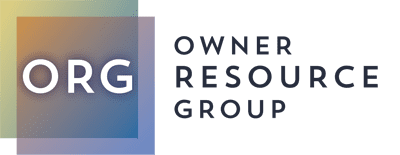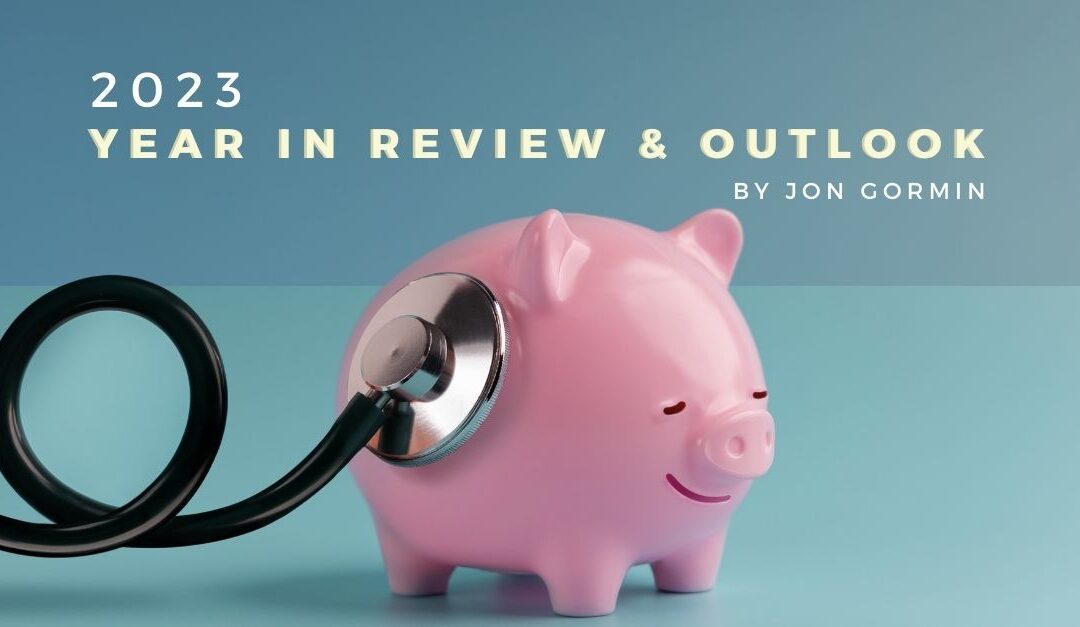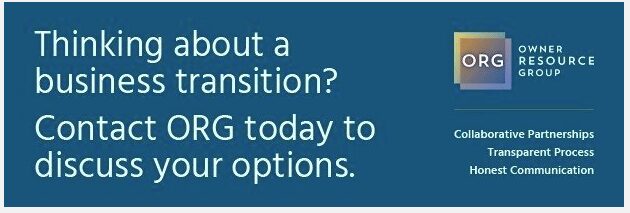Every year I tell myself to do this Year In Review before the end of the year…and every year the New Year rolls around and I haven’t started it yet. I guess my lack of enthusiasm to write my annual Year In Review and Outlook mirrors my lack of enthusiasm for 2024…but at least it’s not 2023.
When I sat around last year we’d been coming off of a wild ride…COVID, Inflation, the Great Resignation, Supply Chain Issues, the Fed Raising Rates…it was all coming fast and furious. Last year I excitedly laid out charts showing everyone that the worst was behind us. COVID, check. Inflation, check. Employment, check. Supply chain, check. It was all heading the right way and the outlook for 2023 looked pretty good (at least for our industries – business services, manufacturing and value-added distribution).
My concern heading into 2023 was the Fed.
“I don’t believe we are going to fall off a cliff but only great companies will see a significant improvement over ’22 and I think it will get harder as the year goes on. Unfortunately, the Fed operates with a hatchet and not a scalpel, so the impact of their actions will take some time to impact the economy.”
My worry was not whether or not the Fed would cool the economy but what, if any, severe damage they would cause. Last March, I thought we had the moment that would tip us from a potential ‘soft landing’ to a full-blown recession.
“I have been in corporate finance for 30 years and I have never seen a severe recession move this slowly. Severe recessions come from shocks to the system – housing market collapses, sovereign country debt implosions, extensive broad-based speculation like the dot-com era.”
I was only concerned we’d enter a recession if something big happened…and, lo and behold, Silicon Valley Bank was big. Bank runs don’t happen frequently but that’s exactly what happened over a 48-hour period of time to Silicon Valley Bank. I believed – and still do believe – that the threat of contagion the weekend of March 10th was real and terrifying. That weekend I drafted a note that we planned to send out and I wrote, “We don’t know what else is now going to break – and things will break this week. The safest path home would be for the government to facilitate a buyout of SVB to minimize the collateral damage or stand behind the depositors accounts.” Fortunately, we never needed to send out that note because the Federal Government both stood behind the depositors accounts and facilitated the buyout of SVB.
After SVB, the investment community, lenders and everyone else did what they should have done…watch and wait. The lending market tightened, especially for larger transactions. The private equity community reduced their activity tremendously. Valuations were unknown in a higher interest rate environment and forecasted business performance was uncertain. Private Equity exits slowed down, fundraising slowed down and cash became king. 2023 turned into a sit-on-your-hands year. The market made little to no sense. Valuations for good, small businesses stayed intact and transactions were completed. Larger companies couldn’t get sold even at historically low valuations. I spoke with lenders that said they didn’t want to participate in syndicated loans so that ‘they could control their own destiny’. And…we were no different in our approach. We completed three add-on acquisitions but made no investments in new platform Partner Companies. We had planned to sell one Partner Company but its performance over the past three years was literally ‘too good’ for buyers to determine how to value it in the current market. My colleagues are loathe to give me any credit, but I can pat my own back touting how correct my prognostications were last year:
- “Cash will become king…and I don’t expect a strong recession.”
- “I expect hiring to become easier for most industries”
- “I don’t believe we are going to fall off a cliff”
- “I think it will get harder as the year goes on.”
- “2023 will probably be a good year to gain market share through acquisitions rather than organic sales channels.”
Perhaps I can have a strong next career as an economist making vast generalizations and (admittedly annoyingly) telling people how right I was. That said – I didn’t see Silicon Valley Bank coming nor a truly ‘messy’ market for buying and selling companies. As to 2024, I am slightly optimistic.
As I look at 2024, I think it will be a slow year that should pick up steam as we move into Q3 and Q4. In talking with our businesses, the end of 2023 wasn’t great. For the most part they were flat to down compared to the same quarter in 2022. Most of their budgets don’t forecast big upticks in 2024 and the feedback they’re getting from their customers is measured.
Hiring for most of our businesses has improved, and previously ‘unfillable’ positions are now filled – with many more hiring options available. That said – for most businesses the beginning of 2024 will be more about cost control and efficiency to generate earnings than robust market growth. Yes, the Fed’s interest rate increases are working. Just like it takes a while for interest rate increases to slow down an economy, it will also take awhile for interest rate cuts or stability to support economic growth.
So – let’s just take a look at one straightforward analysis in real estate (an area far afield from our business but nonetheless illustrative). When interest rate increases started in the US, the average home price was around $350,000. Today it sits just south of $400,000. Before the Fed started its interest rate hikes, the monthly 30-year fixed mortgage payment on that house was around $1,800/month. Over the last several months, the monthly payment for that same house would be around $2,800/month, an increase of over 50%! For most people in the US, their purchasing power is based on their monthly payment, which means that if they wanted to maintain that $1,800/monthly payment they could now only afford a house worth roughly $250,000. That is a HUGE reduction in purchasing power. Now let’s assume the prognosticators are right and interest rates come down such that mortgages can settle in the 5.5% to 6% range. At that point, that same person could afford a house worth around $300,000. This is still a 25% reduction to the previous high, but at least there will be stability…which brings me to my thoughts for 2024.
We have been in wildly uncertain times since COVID and I believe that 2024 will be a transitional year where we find stability. This will take some time. As in my housing example above, if you paid $400,000 for a house and want to sell it, will you be willing to sell it for $300,000 or even $325,000? In 2024, there will be a lot a pricing exploration. It will feel like a good deal compared to 2021, but do we really believe that interest rates will be going back to less than 1% any time soon? Everyone’s collective answer should be that they hope not! Dramatically lower interest rates at this point would mean economic weakness or deflation. Those are bad. It would be far healthier for the markets to re-price, establish a new threshold, and then grow from there. I largely believe this is what’s going to happen in 2024 and why the year will improve as it progresses.
To support this, we have already heard from our lending partners that they are prepared to make loans in 2024. This makes sense. In a rising interest rate environment you don’t know where your losses can end up. With stabilization in rates, and having established adequate reserves to weather the storm over the past year, they know the worst is behind them. Unfortunately, the equity investors have (or will have) lost money, but at some point they’re going to need to take their lumps. This change in attitude from the finance community will help loosen some of the constraints we saw in 2023…but I don’t see anything that makes me think it will be an easy year.
So – although I can keep rolling through a bunch of long-winded thoughts about 2024 and beyond – I will try to wrap this up. The financial community will loosen up in 2024 and this will improve as the year goes on. A big part of this will be finding price stability, which will take time (ie – losses will need to be realized). Hiring people will remain good relative to where it’s been in the past. If you are looking to upgrade talent or add positions, I believe that 2024 will be a good year to do that. The worst of inflation is behind us but won’t be going back below 2% for a long time.
My simple theory here is that we received a 20+ year benefit from China’s growth. Decoupling will have the opposite effect. The good news is that inflation will be nothing like it was post-COVID and we can all survive just fine in a 3%-4% inflation environment.
Finally, there is nothing very exciting economically to start 2024. It’s a good time to focus on operational efficiencies and try to land new customers, but there will be very few markets with robust growth. I believe 2024 will set up for a much more exciting 2025 but we have to get there first!
With this, I will end with my shameless plug for ORG. If you are contemplating a partner in the next couple of years, we would love to talk to you and see if we can find a way to work together. Unlike other private equity firms, we don’t want to be your boss, but instead we want to work with you to co-author your journey. Our Partner companies have typically enjoyed tremendous growth with our support – on average growing their earnings over 230% and doubling their workforces. As your partner, we’d look forward to helping you achieve your goals – and good luck in 2024!


